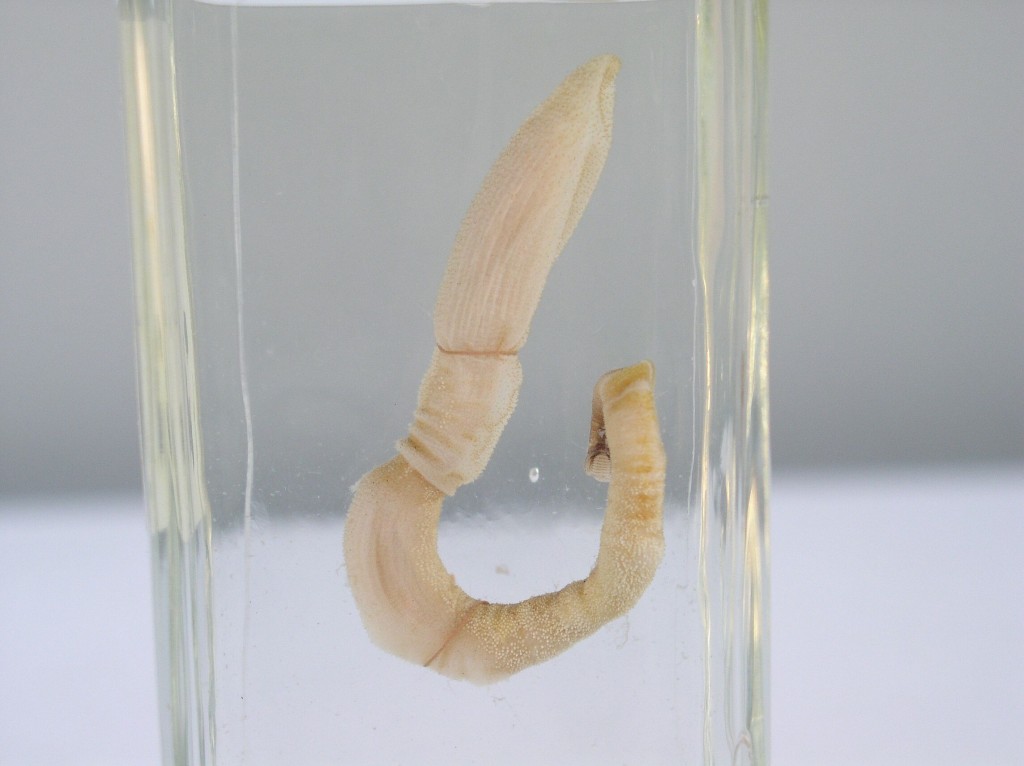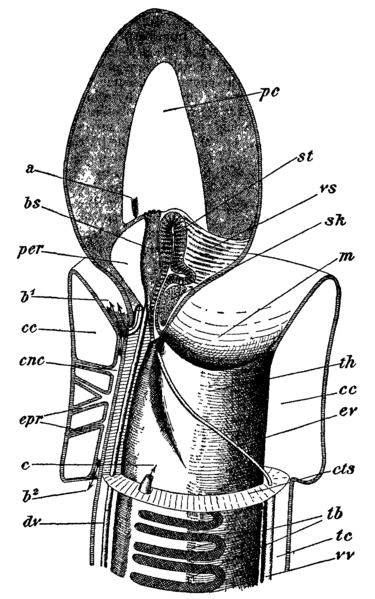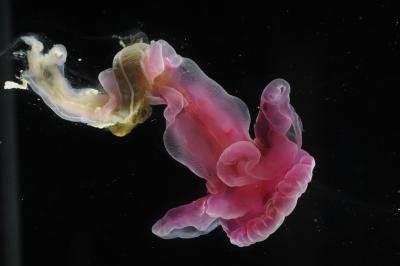
Not going to win any beauty contests: a typical lab-grade acorn worm, an enteropneust. Creative Commons Necrophorus
Behold the lowly acorn worm, ocean filter feeder. Not so impressive, is it? Well, neither would you be were you stuffed for years in a jar filled with formalin. This was the creature portrayed in the video posted last time, as correctly guessed by Mr. Kevin Zelnio of Deep Sea News. As you may have noticed, it has an odd mouth positioned behind a fleshy proboscis attached by a trunk to the center of its mouth. This configuration is the source of the acorn worm’s name. The proboscis fitted into its collar appeared to someone with Naming Powers at some point to look like an acorn. I think acorn is the modest interpretation . Other descriptors come to mind, although another worm already called dibs on that name. Perhaps you can see the acorn better in this figure where the proboscis is not so long:
The proboscis seems to function as trowel, fly paper, and conveyor belt. It digs, it’s coated in sticky mucus, and it is covered with little beating hairs, or cilia, that move food particles back toward the mouth. Inside the mouth are cilia that draw water in as well.
So what’s the big deal about this little worm (also called an enteropneust)? Inside that unprepossessing pallid little body lies a hollow nerve cord and two rows of slits (gills) used for feeding and breathing. By virtue of those gill slits, we know our friend the acorn worm is a descendant of the immediate ancestors of chordates (organisms with a stiffened, fortified nerve cord) and vertebrates (organisms with bony vertebrae defending the nerve cord), and is thus representative of one of the more important evolutionary links in the chain that led to sharks, duck-billed platypuses, and George Clooney (this was obviously a very successful lineage). Very primitive vertebrates may have looked something like them — and at one point, even embryonic you briefly sported a pair of gill-like apparati.
Acorn worms were traditionally classed in a group called the hemichordates, which along with the echinoderms (sea stars, basket stars, sea cucumbers, etc.) are the vertebrates’ closest living relatives. As Colin Tudge notes in “The Variety of Life”, this is quite a remarkable thing.
In short, the chordates, which — in the vertebrates — include the most powerful, most swift, most versatile, and most intelligent creatures that have ever lived, emerged from amongst the ranks of animals that in large part are either sessile or seem to have a hankering to be so and some of which (notably the echinoderms) are without brains, not simply in the loosely perjorative sense but quite literally. Chordates, in short, have strange bedfellows. Nature it seems, likes to startle.
Together, these three groups — the acorn worms, echinoderms, and vertebrates (and possibly one or two other straggler groups) — make up the deuterostomes, a term you may have heard before. The characteristics that reliably define the group are not flashy features found in adults, but minute and highly conserved features of embryonic development (which are thus protected somewhat form the fiercest forces of natural selection) like anal pore formation, embryonic cell cleavage patterns, and larval types, so we will save that story for another day.
As per usual, the biologists are still fighting over what the exact relationships are between these groups. This diagram is as good as any for exploring it.
Most books describe acorn worms as creeping around or living in muddy or sandy U-shaped burrows on the sea floor. They are always depicted as frumpy and vaguely suggestive little creatures like the one pictured at top. When I taught introductory biology in grad school, our teaching specimens came from the same lot, and I remember dutifully fishing one of these not-so-impressive little creatures out of a jar to show my students.
So — and here’s the point of this post — imagine my surprise when last week I opened up a slide show on wired.com of an expedition to either side of the Mid-Atlantic Ridge (run, do not walk, to see) of new finds by British researchers in the Census of Marine Life aboard the RSS James Cook that was practically a debutante ball of brightly colored deep sea acorn worms. Worms with the frill and fuss of bustled, petticoated ladies. Worms that were observed swimming. Acorn worms, that, in short, look nothing like acorn worms. Homely burrowers my arse! Look at the diversity of color and form! On seeing these pictures, it is less hard to imagine the common ancestors of these organisms and us evolving into fish. But as always, these pictures beg the question: What else is awaiting discovery out there . . . ?




{ 2 trackbacks }
{ 1 comment… read it below or add one }
never would have guessed acorn worm! you got me. so i can never wrap my mind around any of your tree of life references, but how cool are all those new deep sea creatures?! love them!